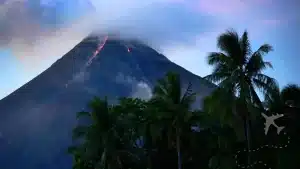Mayon Volcano: A Threatening Force of Nature
Mayon’s 2018 eruptions gave way to a constant stream of lava spilling down the mountainside toward the villages below.
Mayon Volcano (also known as Mount Mayon) started 2018 with a bang – literally. Two lava collapses jolted the 2,447 meter (8,028 foot) smoking stratovolcano back to life and gave way to a constant stream of lava spilling down the mountainside toward the villages below. Eruptions from Mayon are not new – the communities have dealt with eruptions and lahars every few years since the 1800s. In 2008, the 20 meter high lava-flows made it to within 1-2 kilometers of the villages.
The Pacific Ring of Fire is home to Mayon in the Philippines on the southern side of Luzon.
Through the viewfinder
Mayon Volcano Uncensored
If you want to visit, you’ll need to bring shit-load of patience and dust off the life insurance policy. Driving from Manila is a solid 10-12 hours and [honestly] one of the most mentally challenging journeys you’ll ever take. The Philippine infrastructure (outside of Manila) is mostly single-lane roadways with huge potholes, dangerous curves and mountain roads/bridges with [literally] no guard rails.
Legazpi is on the Southern side of Mayon and is usually upwind of the volcanic gasses/ash. This side of the mountain is generally where the lava tends to fall towards and can be viewed easily from anywhere in town. Catching a glimpse of the eruptions at night may be challenging as clouds do cover the summit and the goddamn’ pollution there makes all of your photos hazy.
Hiking to the lava fields on the southern slope of Mayon is a badass experience and one that takes an effort to get some cool selfies. You’ll need a GPS, solid hiking shoes and lots of water.
From the Mayon Helipad, you’ll get a 360-degree view of stunning the beauty of our tiny planet, and you’ll be close enough to HEAR the eruptions. I can’t accurately describe what it sounds like – All I know is that it is a sound I’ll never forget.
Everything you need to know before you visit Mayon Volcano
CURRENT WEATHER
overcast clouds
AIR QUALITY
Good
GPS COORDINATIONS
13.2548, 123.6861
HIGH SEASON (MOST EXPENSIVE)
April – August
November – January
LOW SEASON (LEAST EXPENSIVE)
September – October
February – March











